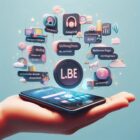What Qualifies You for Safelink Lifeline Assistance?

Are you struggling to make ends meet? Desperately in need of a lifeline? Look no further!
Safelink Lifeline Assistance is here to save the day. Discover the qualifications that can help you access this vital program. From income eligibility requirements to government assistance programs, we’ve got you covered.
Find out how to enroll, the limits, and the documentation needed. Don’t miss out on this opportunity to get the support you deserve.
Key Takeaways
- Income eligibility for Safelink Lifeline Assistance is determined based on the Federal Poverty Guidelines and there are maximum income limits for single-person and two-person households.
- Larger households may have higher income limits and the limitations vary by state, so it is important to check the specific guidelines for your state.
- Participation in government assistance programs such as Medicaid, SNAP, SSI, Federal Public Housing Assistance, and Veterans Pension and Survivors Benefit can increase eligibility chances, as these programs serve as indicators of financial need.
- Only one enrollment per household is allowed, which ensures fair distribution of resources and prevents multiple enrollments within a single household.
Income Eligibility Requirements
To qualify for Safelink Lifeline Assistance, you must meet the income eligibility requirements. The program is designed to provide support to low-income individuals and families, ensuring they’ve access to essential communication services. The income eligibility guidelines are based on the Federal Poverty Guidelines, which take into account your household size and annual income.
As of 2021, the maximum income allowed for a single-person household is $17,388 per year, while a household of two can earn up to $23,517. For larger households, the income limit increases by approximately $6,129 per additional person.
It’s important to note that eligibility is determined by your total household income, which includes income from all sources such as wages, unemployment benefits, social security, and disability payments. However, certain types of income, such as Supplemental Nutrition Assistance Program (SNAP) benefits and Temporary Assistance for Needy Families (TANF) payments, aren’t counted towards the income limit. This ensures that those who are most in need can benefit from the program.
Now that you understand the income eligibility requirements, let’s move on to the next important criteria: household size limitations.
Household Size Limitations
Now that you understand the income eligibility requirements, let’s discuss how household size limitations factor into qualifying for Safelink Lifeline Assistance.
Safelink Lifeline Assistance is a government program that provides free or low-cost cell phone service to eligible low-income individuals and families. When determining eligibility based on household size, the program takes into account the number of people living in the household. Generally, households with more members may be eligible for higher income limits than smaller households. This is because larger households typically have more expenses and financial responsibilities.
To qualify for Safelink Lifeline Assistance, your household size must fall within the program’s defined limitations. The exact limitations may vary depending on the state you reside in, as the program is administered at the state level. For example, in some states, the program may have a maximum household size limit of four members, while in others, it may be higher. It’s important to check the specific guidelines for your state to determine if your household size qualifies for the program.
Understanding the household size limitations is crucial in determining your eligibility for Safelink Lifeline Assistance. In the next section, we’ll explore how participation in other government assistance programs can also impact your qualification for the program.
Government Assistance Programs
When considering your eligibility for Safelink Lifeline Assistance, it’s important to take into account your participation in other government assistance programs. The Lifeline program is designed to support low-income individuals and families by providing affordable phone service. To qualify for Safelink Lifeline Assistance, you must already be participating in one of the following government assistance programs:
| Program Name | Program Type | Program Description |
|---|---|---|
| Medicaid | Health Insurance | Provides healthcare coverage for low-income individuals |
| SNAP (Supplemental Nutrition Assistance Program) | Food Assistance | Helps eligible individuals and families purchase food |
| SSI (Supplemental Security Income) | Income Assistance | Provides cash assistance to low-income individuals with disabilities or elderly |
| Federal Public Housing Assistance | Housing Assistance | Offers affordable housing options for low-income families |
| Veterans Pension and Survivors Benefit | Veterans Assistance | Provides financial support to eligible veterans and their surviving spouses |
These government assistance programs serve as indicators of financial need and can help determine your eligibility for Safelink Lifeline Assistance. It’s important to note that being enrolled in one of these programs does not guarantee eligibility, as each state has its own specific requirements. However, participation in these programs can significantly increase your chances of qualifying for the Lifeline program. Now that you understand the role of government assistance programs in determining eligibility, let’s move on to the next section, where we will discuss lifeline program enrollment limits.
Lifeline Program Enrollment Limits
You can only enroll in the Safelink Lifeline Assistance program once per household. This means that if someone in your household is already enrolled, you won’t be able to apply for the program again. The program is designed to provide assistance to low-income individuals and families, and limiting enrollment to one per household helps ensure that the resources are distributed fairly among those who need them most.
By having this policy, Safelink Lifeline Assistance aims to reach as many eligible households as possible. It prevents multiple enrollments within a single household, which could potentially drain resources and limit the program’s reach to other households in need.
It’s important to note that the eligibility requirements for the program may vary depending on the state you live in. However, the one enrollment per household policy is consistent across all states. Therefore, if you’re already enrolled or someone in your household is, you’ll need to explore other available options for assistance.
Application Process and Documentation Needed
To apply for the Safelink Lifeline Assistance program, you will need to gather the necessary documentation and follow the application process. The application process for Safelink Lifeline Assistance is straightforward and requires you to provide certain documents to prove your eligibility. Here is a table outlining the required documentation for the application:
| Required Documentation | Examples |
|---|---|
| Proof of Identity | State-issued ID, driver’s license, passport |
| Proof of Address | Utility bill, lease agreement, bank statement |
| Proof of Income | Pay stubs, tax return, unemployment benefits statement |
| Proof of Participation | Medicaid card, Supplemental Nutrition Assistance Program (SNAP) documentation |
These documents are necessary to verify your identity, address, income, and participation in a qualifying program. Once you have gathered all the required documentation, you can proceed with the application process. You can apply for Safelink Lifeline Assistance online or by mail. The application will ask for your personal information, such as your name, address, and contact details, as well as the supporting documentation mentioned earlier. After submitting your application, it will be reviewed for eligibility, and you will be notified of the outcome.
Frequently Asked Questions
Can I Apply for Safelink Lifeline Assistance if I Am Currently Receiving Unemployment Benefits?
If you are currently receiving unemployment benefits, you may be eligible to apply for Safelink Lifeline Assistance. Eligibility depends on meeting certain income requirements and being enrolled in a qualifying government assistance program.
Is There a Limit to the Number of Lifeline Program Enrollments That a Household Can Have?
There’s no limit to the number of Lifeline program enrollments a household can have. You can have multiple enrollments as long as each member qualifies individually.
Can I Still Qualify for Safelink Lifeline Assistance if I Am Not a U.S. Citizen?
If you are not a U.S. citizen, you may still qualify for Safelink Lifeline assistance. The program has specific eligibility requirements, which you should check to see if you meet them.
Will My Application for Safelink Lifeline Assistance Be Affected if My Household Size Changes After Enrollment?
If your household size changes after enrollment, it may affect your application for Safelink Lifeline Assistance. Contact Safelink to update your information and discuss any potential impact on your eligibility.
Are There Any Restrictions on the Type of Government Assistance Programs That Qualify an Individual for Safelink Lifeline Assistance?
There are restrictions on the type of government assistance programs that qualify you for Safelink Lifeline assistance. Certain programs, such as Medicaid and Supplemental Nutrition Assistance Program (SNAP), may make you eligible.



